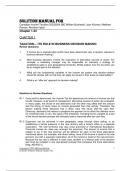Exam (elaborations)
Solution Manual for Canadian Income Taxation 2023/2024 26th Edition by William Buckwold, Joan Kitunen, Matthew Roman, Abraham Iqbal
- Course
- Institution
- Book
Solution Manual for Canadian Income Taxation 2023/2024 26th Edition by William Buckwold, Joan Kitunen, Matthew Roman, Abraham Iqbal
[Show more]




